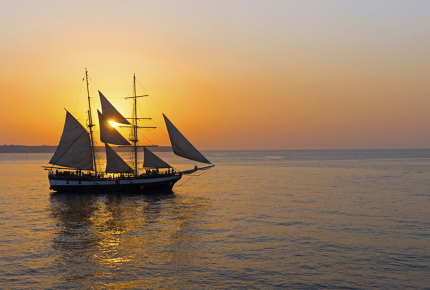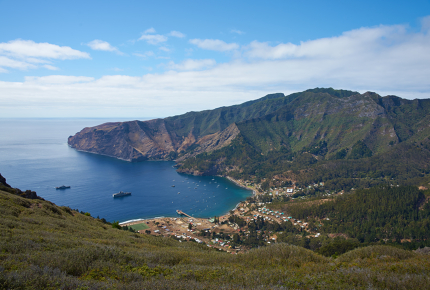How to: Survive on a desert island
Though somewhat inconvenient, becoming a castaway needn’t be a harrowing experience. Heed the lessons of Alexander Selkirk, a sailor who survived alone on an islet for over four years. Jack Palfrey retells his tale.
The roaring winds of the South Pacific buffer the bow of the Duke, a hardy British frigate, moored near the craggy island of Más a Tierra.
Aboard, the ship’s captain and experienced seahand, Woodes Rogers, awaits news from the small landing party that have gone ashore, investigating bright lights they believe to be French sailors stocking up on supplies.
Rogers whiles away the idle hours scribbling in his diary, a soiled manuscript that will go on to be published in England under the title: A Cruising Voyage Around the World.
“February 2, 1709: We are all convinc’d the light is on the shore, and design to make our ships ready to engage, believing them to be French ships at anchor,” he wrote.
As the sun bows to kiss the Pacific Ocean, Rogers becomes worried. Fearing his men have been captured, he commands a signal be raised for the crew to return. When he finally spies the returning boat, he is stunned by what he sees.
“Our Pinnace return’d from the shore, and brought abundance of Craw-fish, with a Man cloth’d in Goat-Skins, who look’d wilder than the first Owners of them,” he scribbled.
The wild man was Alexander Selkirk, a Scottish sailor who had been living alone on the small atoll for the last four years.
“At his first coming on board us, he had so much forgot his language for want of use, that we could scarce understand him,” authored Rodgers. “We offered him a Dram, but he would not touch it, having drank nothing but Water since his being there.”
The feral Selkirk intrigued Rogers. He admired his physical prowess and was impressed by his resourcefulness, inviting him to be a mate aboard Duke.
As a dense darkness smothered the vessel, Rogers ushered Selkirk below deck, hoping to be regaled by the castaway’s tale under candlelight.
Selkirk was marooned on Más a Tierra after a disagreement with his then captain over the seaworthiness of his ship. Selkirk dramatically suggested he would rather stay on the island than sail on.
His captain, somewhat of a literalist, left Selkirk ashore with his bedding, clothes, firelock, gunpowder and bullets. He also had his tobacco, a hatchet, a knife, a kettle, a bible and his mathematical books.
Grappling with a strong sense of despair, Selkirk turned his attention to survival.
 Selkirk was found by chance by a privateering expedition
Selkirk was found by chance by a privateering expeditionelxeneize / Thinkstock
At first he went without food, hankering after bread and salt instead, but as hunger engulfed him, he hunted the goats that had been introduced by a fledgling Spanish colony, which had since fled to Chile.
For shelter, he fashioned two huts from Pimento trees, covered them with long grass and lined them with goatskins.
“He provided for himself as well as he could,” wrote Rodgers, “but had much ado to bear up against Melancholy, and the Terror of being left alone in such a desolate place.”
He spent most days reading, singing psalms and praying, telling Rodgers that the solitude had made him a better Christian.
The nights however were much worse. The fires he made using his powder did little to ward away the population of feral rats, which feasted on his flesh as he slept.
When he ran out of gunpowder, Selkirk resorted to hunting goats by hand, an exuberant practice that almost cost him his life. He had chased a goat with such ferocity that he fell from a concealed cliff.
“He was so stun’d and bruis’d with the fall, that he narrowly escap’d with his life,” Rodgers regaled, “when he came to his senses, found the goat dead under him.”
Selkirk lay there for 24 hours, summoning just enough strength to crawl back to his makeshift hut. He didn’t resurface for 10 days. Injured and with little hope of rescue, Selkirk was left to contemplate his own mortality.
As the Duke rocks on the rolling tide, wax trickles from the depleted candlesticks. Despite a tiresome day Rogers still sits attentively, straining to take in every word of Selkirk’s turbulent tale.
Recovering from his injuries, Selkirk accepted his rescue chances were diminishing. He slowly began adapting to primitive island life instead.
The physical excursion made him fit and strong, chasing goats increased his agility, and his feet became so hard he could run everywhere without annoyance.
“He ran with wonderful swiftness, as we perceiv’d when we emoloy’d him to catch goats for us,” wrote Rodgers. “We had a bulldog, which we sent with several of our nimblest runners, to help him in catching goats; but he tir’d both the dog and the men, catch’d the goats and brought ‘em to us on his back.”
He also became more resourceful, scouring the island for vegetation and stumbling on a patch of turnips, cabbage trees and a black pepper called Malagina, which was “very good to expel wind, and against griping of the guts.”
To improve his sleeping situation, he domesticated a group of wild cats, feeding them fish and goat broth. In turn the cats protected him from the vermin rats while he slept.
When his clothes wore out, he made himself a coat and cap of goat skins. He also fashioned himself shirts with the little linen he had, sowing them together with a nail. His sowing skills sufficed until the land party from the Duke arrived - just.
“He had his last shirt on when we found him in the land,” wrote Rodgers.
 Modern-day Más a Tierra is now known by another name
Modern-day Más a Tierra is now known by another nameJeremy Richards / Thinkstock
It was very late in the evening now and the candle flames squirmed to keep alight. Selkirk, no doubt excited at the thought of a night spent under cover, retired to his quarters, leaving Roger scribbling a flurry of thoughts into his diary.
“We may perceive by this story the truth that solitude and retirement from the world is not such an unsufferable state of life as most men imagine,” he scribbled.
“It may likewise instruct us how much a plain and temperate way of living conduces to the Health of the body and the vigour of the mind, both of which we are apt to destroy by excess and plenty, especially of strong liquour, and the variety as well as the nature of our meat and drink: for this man, when he came to our ordinary method of diet and life, lost much of his strength and agility,” concluded Rodgers.
After his rescue, Selkirk returned to Scotland, eloped, drank and then returned to sea, where he caught yellow fever and quietly perished.
If only he’d remained on his island, which today is named after the fictional character that Selkirk’s story inspired: Robinson Crusoe.
---
Selkirk’s story is told in further detail in Woodes Rogers’ memoir A Cruising Voyage Around the World (1712). A recent edition, available to purchase online, is published by The Narrative Press.
Do you have any Feedback about this page?
© 2025 Columbus Travel Media Ltd. All rights reserved. No part of this site may be reproduced without our written permission, click here for information on Columbus Content Solutions.









 You know where
You know where